Sulaiman
International Hazard
    
Posts: 3558
Registered: 8-2-2015
Location: 3rd rock from the sun
Member Is Offline
|
|
Overhead Stirring
Does anyone have experience with the simple ptfe overhead stirrer as available via eBay ?
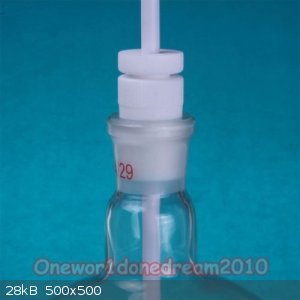
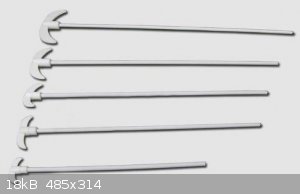
Specifically I'd like to know;
. do they seal (e.g. H2O EtOH Cl2 NOx ...) well at atmospheric pressure?
. what rpm range are they usable at ?
. how well do they seal against vacuum ?
. is lubrication advisable ?
I hope to answer these questions within months as I've just ordered a NS24 set (£12)
but I'd like to hear any comments before I start.
I intend to update this thread with some results .... eventually.
/\/\/\/\/\/\/\/\/\/\/\/\/\/\/\/\/\/\/\/\/\/\/\/\/\/\/\/\/\/\/\/\/\/\/\/\
Side Note
I am investigating overhead stirring mainly because I disassembled a cheap hand blender and gained a nice dc motor,
https://www.tesco.com/direct/tesco-hbs07-300w-11l-hand-blend...
the blender was super-simple, 230 Vac input, full-wave or half-wave rectified for high/low speed.
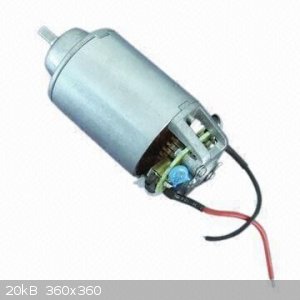
The motor is rated for 300W, 230V dc, I guess about 10,000 rpm no-load.
At lower dc voltages it is (I hope) ideal as an overhead stirrer motor,
it even fits perfectly in a 4-prong retort clamp 
..........................................................................................
A similar motor via eBay http://www.ebay.co.uk/itm/Hot-Magnet-DC-Motor-High-Power-Spe...
[Edited on 18-5-2017 by Sulaiman]
CAUTION : Hobby Chemist, not Professional or even Amateur
|
|
|
JJay
International Hazard
    
Posts: 3440
Registered: 15-10-2015
Member Is Offline
|
|
I've used those paddles and bearings. It is possible for the reaction mixture to make limited contact with the stainless steel under the PTFE coating
on the paddle. I have used them to stir refluxing mixtures and never noticed any leakage, but if you have to stir something that is really sensitive
to air, it's probably a good idea to maintain a slight positive pressure in your apparatus, and I think it is highly unlikely that those bearings will
hold a vacuum while stirring. The bearings are good for maybe 1000 RPM; beyond that, the Viton o-ring used for the seal will burn up. 10,000 RPM is
way too fast... I'd suggest using a stepper motor so you can stir at low RPM if you like. It's not clear to me whether that is a brushed motor (I am
guessing it is), but you definitely want to use one that won't give off sparks if you stir anything flammable.
[Edited on 18-5-2017 by JJay]
|
|
|
Sulaiman
International Hazard
    
Posts: 3558
Registered: 8-2-2015
Location: 3rd rock from the sun
Member Is Offline
|
|
Yes it is a simple permanent magnet, mechanically commutated, carbon brushed, dc motor,
D'oh! ... I forgot that it makes sparks  
(I think that I can maybe mitigate that risk with wire mesh)
IF 10,000 rpm at 230 Vdc then about 1,000 rpm at 23 Vdc etc.
full torque should be available at all rpm for dc motors.
(about 50 Ohm dc effective resistance in my motor)
I've not decided on the controller yet, I'm testing it using a 0-30 Vdc psu
but ultimately I'll probably use a phase angle light-dimmer and full-wave rectifier,
or pwm a dc supply, or use whatever eBay module looks cheap'n'easy.
This stirrer should be an interresting experiment in itself.
To test ignition by sparcs/arcs, what would be more 'sensitive' than diethyl ether ?
[Edited on 18-5-2017 by Sulaiman]
CAUTION : Hobby Chemist, not Professional or even Amateur
|
|
|
JJay
International Hazard
    
Posts: 3440
Registered: 15-10-2015
Member Is Offline
|
|
Hydrogen gas. Acetylene.
|
|
|
Sulaiman
International Hazard
    
Posts: 3558
Registered: 8-2-2015
Location: 3rd rock from the sun
Member Is Offline
|
|
Excellent !
I'll blow acetylene gas (from calcium carbide) through the motor as soon as the weather permits me to work outside.
[Edited on 18-5-2017 by Sulaiman]
CAUTION : Hobby Chemist, not Professional or even Amateur
|
|
|
Magpie
lab constructor
    
Posts: 5939
Registered: 1-11-2003
Location: USA
Member Is Offline
Mood: Chemistry: the subtle science.
|
|
I have used the ptfe stirring assembly that you show often. It is generally satisfactory but as JJ says I would not count on it for absolute
leakproofing for either pressure or vacuum. I usually apply a little silicone grease to the Viton O-ring - how much good this does I don't know.
I use a salvaged stepper motor as driver and it does a good job as it has high torque capability. Up until now I could only go as high as 220 rpm as
my power supply was only good for 12vdc. But now with my new Mastech power supply I can set 18vdc and drive the stepper to over 700 rpm! I think
that for settleable solids (like small sand particles) one needs at least 600 rpm.
When using iron powder for reductions I believe a high rpm, say 700-1000, would also be required.
I also am doing some development work and lab evaluations in the area of overhead mixers and mixing. I like the folding prop design supplied in ptfe
that you show but am also looking at ss propellor designs for non-rbf use.
FYI I have also posted about my speed controller and rpm meter (cheap from China) elsewhere on this forum.
The single most important condition for a successful synthesis is good mixing - Nicodem
|
|
|
Dr.Bob
International Hazard
    
Posts: 2658
Registered: 26-1-2011
Location: USA - NC
Member Is Offline
Mood: No Mood
|
|
If anyone wants the glass shafts or bearering (PTFE or glass/oil type), or paddles for them, I have scads. I need to post a few photos, but I have
all sorts of them. I even have some glass propeller types. See below for examples:
http://www.thomassci.com/Equipment/Stirrer-Shafts/_/F37970-6...
https://medlabequipment.com/product/talboys-987424-solid-gla...
|
|
|
Magpie
lab constructor
    
Posts: 5939
Registered: 1-11-2003
Location: USA
Member Is Offline
Mood: Chemistry: the subtle science.
|
|
Today I'm making "dry" ethanol from Everclear using Vogel's CaO drying then polishing with 3A mole sieves. Since I'm using a ptfe bearing/stuffing box
and ptfe paddle I thought I would show a picture of what I use:
If the stuffing box is too tight it will overload my stepper motor driver. It did shut down on overheating after ~40 minutes. I replaced the paddle
with a slightly smaller one with a slightly smaller diameter shaft then added a computer fan for cooling. I increased the rpm from 100 to 445.
Everything is running well now at 18vdc, 0.2a. Wtih the other paddle the amps =0.4 at 18vdc.
One problem looking for a better solution is that the bearing tends to ride up and out of the tapered glass fitting. I've got it secured with a heavy
rubber band for now.
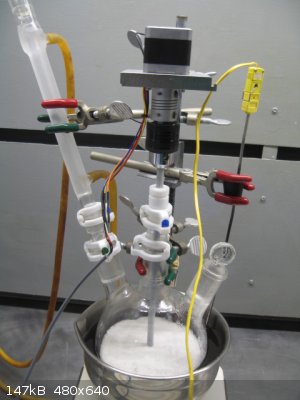
[Edited on 27-5-2017 by Magpie]
The single most important condition for a successful synthesis is good mixing - Nicodem
|
|
|
PirateDocBrown
National Hazard
   
Posts: 570
Registered: 27-11-2016
Location: Minnesota
Member Is Offline
Mood: No Mood
|
|
My experience with these has been positive, but it was in 2 piece kettle reactors, under N2, and with reactants insensitive to stainless steel.
I could not comment on use of vacuum, nor with metal-sensitive reaction.
|
|
|
Sulaiman
International Hazard
    
Posts: 3558
Registered: 8-2-2015
Location: 3rd rock from the sun
Member Is Offline
|
|
OK , looking good, with a few cautions. thanks.
I am planning to use a rigid coupling directly between motor and stirrer shafts,
but I see Magpie using a flexible coupling and a chuck,
would this type of flexible coupling be better or worse than a rigid one ?
CAUTION : Hobby Chemist, not Professional or even Amateur
|
|
|
Magpie
lab constructor
    
Posts: 5939
Registered: 1-11-2003
Location: USA
Member Is Offline
Mood: Chemistry: the subtle science.
|
|
I like a chuck for its versatility and for ease of system assembly/disassembly.
I bought the coupler simply as a way to connect the chuck to the motor shaft. It's very stiff and does no flexing. The chuck can be unscrewed from
the coupler.
As you say there are other ways to make the motor-paddle connection.
[Edited on 28-5-2017 by Magpie]
The single most important condition for a successful synthesis is good mixing - Nicodem
|
|
|
Magpie
lab constructor
    
Posts: 5939
Registered: 1-11-2003
Location: USA
Member Is Offline
Mood: Chemistry: the subtle science.
|
|
Here's a picture where I'm distilling off the ethanol (<1% water) from the CaO/Ca(OH)2 slurry. The 500 ml receiver contains 3A mole sieves.
The mixer ran cool at 489 rpm, 18vdc, 0.2a. I added the computer fan but the main improvement was just setting the rpm sufficiently high. At that
rpm I could barely hear it run. I'm still learning about the operating characteristics of a stepper motor.
You can just see the red rubber band that I used to hold the ptfe bearing in place.
Edit: In review, less friction at the stuffing box due to the slightly smaller shaft was likely the main improvement.
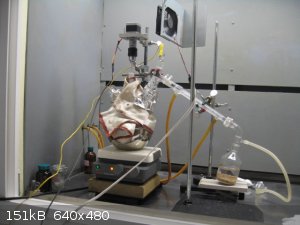
[Edited on 29-5-2017 by Magpie]
The single most important condition for a successful synthesis is good mixing - Nicodem
|
|
|